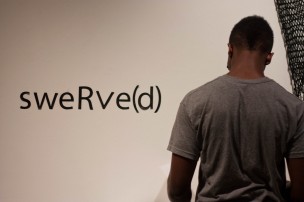
Sydney Lowe/Contributing Photographer
Swerve(d), Wesleyan’s digital forum for exhibiting any and all student artwork in any and all forms, is no longer just a website; it has veered off into real life, or more specifically, the Zilkha Gallery. From Wednesday, Nov. 10 to Tuesday, Nov. 22, Swerve(d) is hosting a real live art show of works featured on their website that have never before been seen except for on a computer screen.
Although Swerve(d) is an online forum for viewing Wesleyan students’ art, its goal is not just to make student creativity available on the Internet.
“Most of what the goals are for the site are to up the visibility of creative culture on campus as a whole,” said Laura Lupton ’12, one of the creators of the site. “A really effective way of doing that is having a website because everyone uses the Internet….but that’s not the only effective way.”
In fact, Lupton pointed out, “the Swerve(d) show is the only opportunity for students who are not studio majors or in studio classes to have their work displayed in Zilkha, so it’s the only opportunity for students on campus who aren’t necessarily in the actual academic studio department to get the creative stuff they’re doing seen [in person] by people on campus.”
The showcase consists of pieces from all different mediums, from digital photos, to paintings, and yes, to sculptures too, including one piece made of bottles and picture frames.
“[We included] work that we thought would benefit from being seen in real life, as opposed to just on an interface of a computer screen,” Lupton said.
Like many student groups on campus, the power outage put a bit of a kink in their plans, as it occurred while submissions for the live show were pouring in. Neither artists nor Swerve(d) members could access the Internet to send pieces or make selections between the pieces until power was restored.
However, Lupton said, “We ended up getting enough really good solid work that, regardless of the power outage, we had some really good submissions to choose from.”
In the show, predictably, the pieces that benefited from the live viewing the most were the sculptural works, such as the piece by Alex Chaves ’12. Serving as what seemed to be the focal point of the show, his large knitted web of black thread hung on the back wall of the gallery as if in the process of falling apart. It was the first thing you saw walking into the room. The visual impact was greatly enhanced by the actual physical presence of his sculpture, and I can’t imagine what the work would be reduced to if only seen as a digital picture.
Two other works that stuck out (quite literally) were a series of three paintings/collages by Khari Slaughter ’13 and a painting by Piers Gelly ’13 called “Translation.” In both these pieces, the viewing of the physical object seemed essential to transmitting their messages. Slaughter’s works appear much more gritty and visceral in real life than on the Swerve(d) website, which adds an essential quality of uncomfortableness to the images. The physicality of Gelly’s painting made a stronger emotional impact—you could actually see the brushstrokes applied and paint clumping on the figures, lending to the drama and weight of the painting.
Another notable part of the exhibition was Method Magazine’s interactive “confessional” in the corner of the room, called “Confessions Part I.” There, in a small room covered in lace and religious imagery, the viewer who entered was asked to write a “confession” and place it in a submission box, all while the benevolent god of rap and R&B, Usher, looked down upon you. According to the instruction next to the exhibit, the confessions you submit will be “curated” in the Spring issue of Method, presumably titled “Confessions Part II.”
Among the 3D works, there were also 2D pieces that profited from the chance to be seen in the real world. This was especially true for series of images, which on the website must be scrolled through. In the gallery, they could be viewed all with one glance and seen as the unit that they are. By viewing Wyatt Hodgson’s ’14 series of pictures together at once, the progression and synergy of the work was really made apparent.
The only criticism of the show is that it was a bit heavy on the 2D pieces, but that can be chalked up to the fact that most of the works a website would receive and have to choose from only have two dimensions. Still, the few sculptures kept it lively, and the 2D works are definitely enough to hold your attention as you move through the room.
Although occasionally with Facebook, as well as the host of other social networking things, the Internet can feel like real life, Swerve(d)’s move from digital to temporal proved the opposite; some art is really only seen and felt properly out in the physical world.